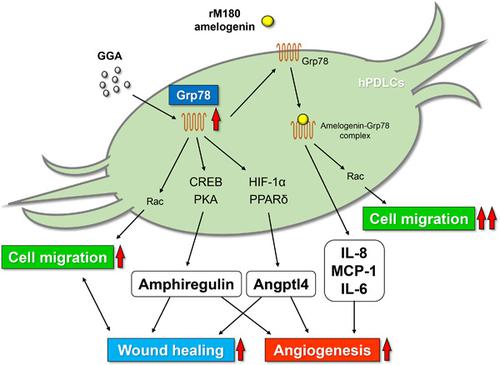当前位置:
X-MOL 学术
›
J. Cell. Biochem.
›
论文详情
Our official English website, www.x-mol.net, welcomes your feedback! (Note: you will need to create a separate account there.)
Combined application of geranylgeranylacetone and amelogenin promotes angiogenesis and wound healing in human periodontal ligament cells
Journal of Cellular Biochemistry ( IF 4 ) Pub Date : 2021-02-02 , DOI: 10.1002/jcb.29903 Hiroaki Yamato 1 , Terukazu Sanui 1 , Karen Yotsumoto 1 , Yuki Nakao 1 , Yukari Watanabe 1 , Chikako Hayashi 1 , Ryosuke Aihara 1 , Misaki Iwashita 1 , Urara Tanaka 1 , Takaharu Taketomi 2 , Takao Fukuda 1 , Fusanori Nishimura 1
Journal of Cellular Biochemistry ( IF 4 ) Pub Date : 2021-02-02 , DOI: 10.1002/jcb.29903 Hiroaki Yamato 1 , Terukazu Sanui 1 , Karen Yotsumoto 1 , Yuki Nakao 1 , Yukari Watanabe 1 , Chikako Hayashi 1 , Ryosuke Aihara 1 , Misaki Iwashita 1 , Urara Tanaka 1 , Takaharu Taketomi 2 , Takao Fukuda 1 , Fusanori Nishimura 1
Affiliation

|
Amelogenin directly binds to glucose‐regulated protein 78 (Grp78). Cell migration activity is expected to increase when human periodontal ligament cells (hPDLCs) overexpressing Grp78 are treated with amelogenin. Geranylgeranylacetone (GGA) is a drug that induces the expression of heat shock protein and is routinely used to treat gastric ulcers. Here, we investigated the changes in the properties and behavior of hPDLCs in response to treatment with GGA and the synergistic effects of amelogenin stimulation in hPDLCs pretreated with GGA for the establishment of a novel periodontal tissue regenerative therapy. We observed that GGA treatment increased Grp78 protein expression in hPDLCs and enhanced cell migration. Microarray analysis demonstrated that increased Grp78 expression triggered the production of angiopoietin‐like 4 and amphiregulin, which are involved in the enhancement of angiogenesis and subsequent wound healing via the activation of hypoxia‐inducible factor 1α and peroxisome proliferator‐activated receptors as well as the phosphorylation of cAMP response element‐binding protein and protein kinase A. Moreover, the addition of recombinant murine amelogenin (rM180) further accelerated hPDLC migration and tube formation of human umbilical vein endothelial cells due to the upregulation of interleukin‐8 (IL‐8), monocyte chemotactic protein 1, and IL‐6, which are also known as angiogenesis‐inducing factors. These findings suggest that the application of GGA to gingival tissue and alveolar bone damaged by periodontal disease would facilitate the wound healing process by inducing periodontal ligament cells to migrate to the root surface and release cytokines involved in tissue repair. Additionally, supplementation with amelogenin synergistically enhanced the migratory capacity of these cells while actively promoting angiogenesis. Therefore, the combined application of GGA and amelogenin may establish a suitable environment for periodontal wound healing and further drive the development of novel therapeutics for periodontal tissue regeneration.
中文翻译:

香叶基香叶基丙酮与牙釉蛋白联合应用促进人牙周膜细胞血管生成和伤口愈合
牙釉蛋白直接与葡萄糖调节蛋白 78 (Grp78) 结合。当用牙釉蛋白处理过表达 Grp78 的人牙周膜细胞 (hPDLCs) 时,预计细胞迁移活性会增加。Geranylgeranylacetone (GGA) 是一种诱导热休克蛋白表达的药物,常用于治疗胃溃疡。在这里,我们研究了 hPDLCs 响应 GGA 治疗的特性和行为的变化以及牙釉质刺激在用 GGA 预处理的 hPDLCs 中的协同作用,以建立一种新的牙周组织再生疗法。我们观察到 GGA 处理增加了 hPDLCs 中 Grp78 蛋白的表达并增强了细胞迁移。微阵列分析表明,增加的 Grp78 表达触发了血管生成素样 4 和双调蛋白的产生,这些发现表明,将 GGA 应用于牙周病损伤的牙龈组织和牙槽骨将通过诱导牙周膜细胞迁移到牙根表面并释放参与组织修复的细胞因子来促进伤口愈合过程。此外,补充牙釉蛋白可协同增强这些细胞的迁移能力,同时积极促进血管生成。因此,GGA和牙釉蛋白的联合应用可以为牙周伤口愈合建立合适的环境,并进一步推动牙周组织再生新疗法的发展。
更新日期:2021-02-02
中文翻译:

香叶基香叶基丙酮与牙釉蛋白联合应用促进人牙周膜细胞血管生成和伤口愈合
牙釉蛋白直接与葡萄糖调节蛋白 78 (Grp78) 结合。当用牙釉蛋白处理过表达 Grp78 的人牙周膜细胞 (hPDLCs) 时,预计细胞迁移活性会增加。Geranylgeranylacetone (GGA) 是一种诱导热休克蛋白表达的药物,常用于治疗胃溃疡。在这里,我们研究了 hPDLCs 响应 GGA 治疗的特性和行为的变化以及牙釉质刺激在用 GGA 预处理的 hPDLCs 中的协同作用,以建立一种新的牙周组织再生疗法。我们观察到 GGA 处理增加了 hPDLCs 中 Grp78 蛋白的表达并增强了细胞迁移。微阵列分析表明,增加的 Grp78 表达触发了血管生成素样 4 和双调蛋白的产生,这些发现表明,将 GGA 应用于牙周病损伤的牙龈组织和牙槽骨将通过诱导牙周膜细胞迁移到牙根表面并释放参与组织修复的细胞因子来促进伤口愈合过程。此外,补充牙釉蛋白可协同增强这些细胞的迁移能力,同时积极促进血管生成。因此,GGA和牙釉蛋白的联合应用可以为牙周伤口愈合建立合适的环境,并进一步推动牙周组织再生新疗法的发展。



























 京公网安备 11010802027423号
京公网安备 11010802027423号